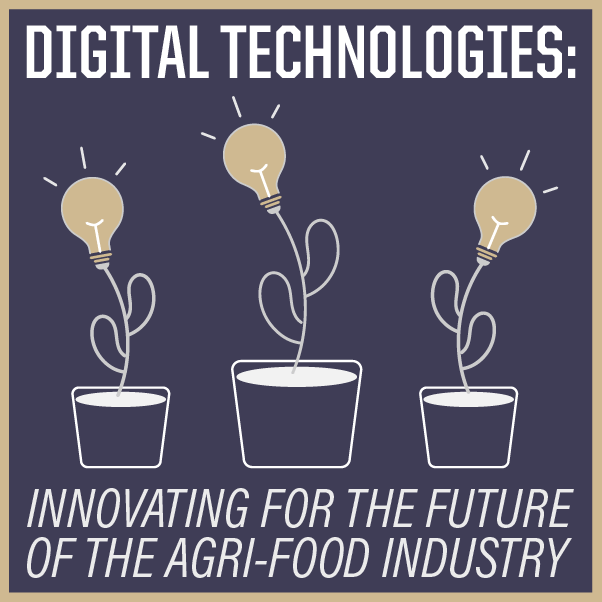Rev iewer
iewer
Dr. Lourival Carmo Monaco Neto, Postdoctoral Research Associate
Report
Future of Food: Harnessing Digital Technologies to Improve Food System Outcomes by Townsend, R., Lampietti, J., Treguer, D., Schroeder, K., Haile, M., Juergenliemk, A., Hasiner, E., Horst, A., Hakobyan, A. with inputs from Varangis, P. Arias, D., Bujoreanu, L., Kim, J., Fernandes, E., Shah, P., Umali-Deininger, D., Morris, M., Preneuf, F., Fay, M., Saint-Geours, J., Jagwani, A., Moses, G., Bethe, E., Bogdanic, M., Rogy, M., Treadwell, J., Krishnan,, R., Kennedy Freeman, K., Gaskell, J., Stickler, M., Sebastian, A., Won Lee, H., Khouri, N., Guo, L., and Jakobs de Padua, A. Overall guidance provided by Voegele, J., Nieuwkoop, M., and Ehui, S.
Source
World Bank Group, 2019
According to McKinsey & Company, April 21, 2021 was marked as World Creativity and Innovation Day. As we know, innovation is a hot topic that is currently reshaping agriculture from farm to fork. Cambridge Dictionary defines innovation as “a new idea or method, or the use of new ideas and methods”. To dig deeper into the concept of innovation, it is possible to say that an innovation system is a coherent set of interdependent processes and structures that dictates how a company searches for novel problems and solutions, synthesizes ideas into business concepts and product designs, and selects which projects get funded. The focus of innovation is often centered around a new or improved product, targeting an increased market share.
All this being said, innovation is not a synonym to disruption. Business disruption happens when an existing industry faces a challenger that offers far greater value to customers in a way that existing firms cannot compete with directly (ROGER, 2016). Disruption displaces an existing market, industry or technology and produces something new, more efficient and worthwhile. In the current state of the agribusiness sector, we are looking for disruptive innovations, which involves more than simply applying technologies to make farming more productive. Rather, it involves rethinking the system we currently have and redesigning it to be more efficient, sustainable and interesting for all stakeholders involved.
Considering how digital technologies are flourishing, it is impossible to imagine disruptive innovations that don’t involve digital technologies. Due to many factors such as cost reduction, knowledge advances and diffusion, these technologies are more present than ever before, including in the business world.
In 2015, The McKinsey Global Institute released its Industry Digitization Index in which agriculture was shown to be far behind in the digital revolution. Similarly, the food industry was identified within the basic goods manufacturing and retail trade sectors and showed a bit more advancement in digitization, yet still had substantial room for improvement (Manyika, et.al. 2015). Since this time, much has been done in this area and a great evolution has been observed, but there is still much to be improved.
The agri-food system is ripe for expanded use of digital innovations for several reasons, like:
- It’s large and complex with many actors;
- It has a vast array of inefficiencies (unsustainable use of land and water, significant food loss and waste, etc.); and
- There is asymmetric access to technologies, knowledge, information and markets (the vast majority of the 1.2 billion people worldwide not covered by a broadband-capable network live in rural areas).
The list of technological/digital developments allowing such disruptive innovations in the agricultural sector is enormous and extremely dynamic as new things and uses are being discovered every day. Some examples are:
- Advances in data collection technologies (in situ and remote sensors);
- Adoption of precision agriculture machinery (digitization and datafication of agriculture);
- Advances in data processing (artificial intelligence, Internet of Things, cloud computation and increased computing power);
- Advances in encryption, data protection and data sharing technologies, and institutions for data sharing (confidential computing and multi-party computation, synthetic data release and advances in data visualization software);
- Advances in institutions for data sharing (reducing information gaps, information asymmetries, administrative costs such as transaction costs, and incentive non-alignment);
- Distributed ledger technologies (DLTs) and smart contracts (improving product traceability and integrity, contract certainty, proof/verification of geographic origin, and compliance with sanitary and phytosanitary requirements);
- Food-sensing technologies;
- Digitally enabled marketplaces for agricultural products (e-platforms);
- E-extension services; and
- Digitization of transactions and payments and data analytics (credit access and use).
What is truly amazing is that these technologies are allowing for great advancement in many areas of the agricultural sector, which are where these disruptive innovations are coming from. Some of these advancements include:
- Improving the use of capital, including machinery and equipment, increasing its technical and allocative efficiency;
- Reducing the costs of linking sellers and buyers;
- Reducing inequalities in access to information, knowledge, technologies and markets;
- Helping farmers make more precise decisions on resource management, efficiency and risk mitigation by providing, processing and analyzing an increasing amount of data faster;
- Enhanced monitoring and evaluation of outcomes in agriculture; and
- Facilitating the acquisition of skills and knowledge needed for agricultural production, improving labor efficiency and the optimal use of inputs.
Of course, all of this does not come without challenges and barriers. The need for financial resources to fund these technologies, creation of privacy or confidentiality regulations and standards (while not stifling innovation) and development of a data infrastructure (which encompasses interoperability rules, data quality standards, norms or regulations on data ownership and data privacy, shared modelling frameworks, shared databanks, digital platforms, cloud-based storage and processing, etc.) are simply a few areas that pose such challenges.
Perhaps one of the most important aspect to be developed in order for these new technologies to produce truly disruptive innovations in the agricultural sector is the data/analytical capabilities of the professionals driving data into actionable intelligence. Considering the Resource-Based View conceptual framework, to be able to leverage assets (in this case, data) to achieve competitive advantage, the right competencies must be present. Professionals in the agricultural sector will have to be versed in data analytics and immersed in a new organizational culture — one that is data-driven and results-oriented.
The main takeaway from this report is that disruptive innovation is the way forward in the agricultural sector. This road will be paved by digital technologies, but many obstacles — both structural and cultural — will have to be overcome. The key focus should be put on having the right capabilities to achieve the end goal: revolutionize agriculture from farm to fork.
References
Manyika, J., Ramaswamy, S., Khanna, S., Sarrazin, H., Pinkus, G., Sethupathy, G., Yaffe, A. “Digital America: A Tale of the Haves and Have-Mores”. McKinsey Global Institute. 2015.
Roger, L. D., The Digital Transformation Playbook. 2016.



